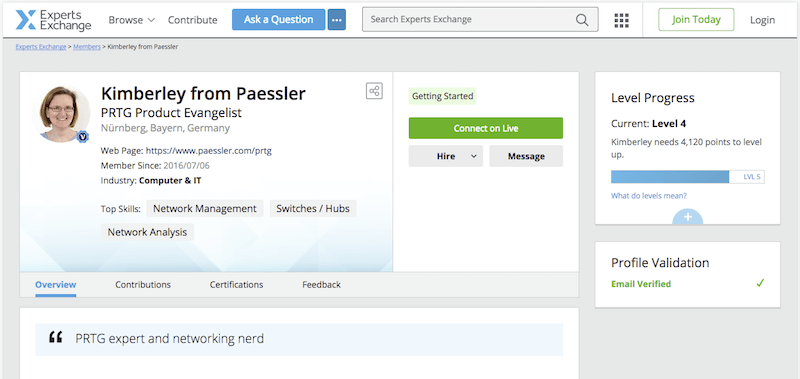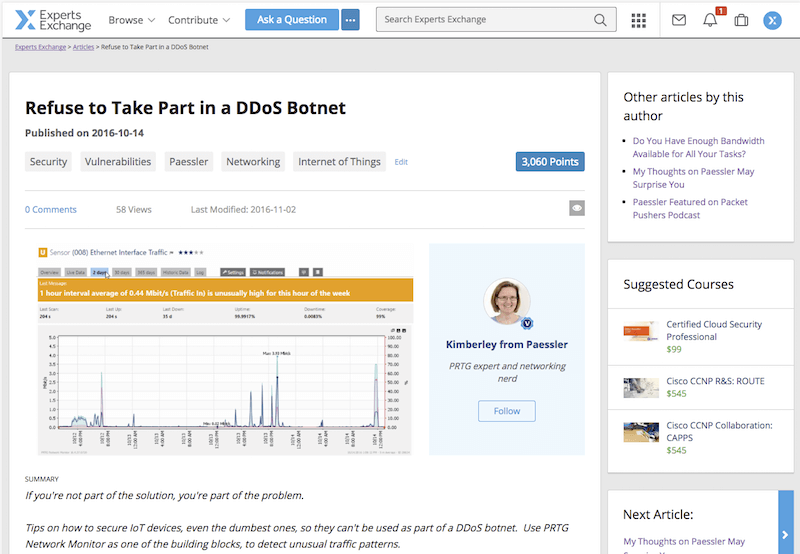
Since the dawn of the internet, people have been drawn to online communities for collaborating and advancing knowledge. Discussions that previously took place in the depths of Usenet are now emerging on Reddit. In a matter of seconds, you can find massive online communities dedicated to everything from astrophysics to Zen.
As a marketer, it’s easy to look at a community devoted to something related to your brand and see green. However, if you plunge into a community with your marketing hat on, there’s a good chance things will go awry. Even the perfect community for your brand can morph into Medusa with the wrong approach, which is why we’re here to share some secrets.
In communities, it can be much more effective to educate (even through advertisements), rather than sell. It’s a longer sales cycle, but it’s often rewarded with a significantly longer customer lifetime value and a fiercely loyal group of brand ambassadors.
At Experts Exchange, we’ve managed one of the largest technical communities online for 20 years now, and we’ve learned a thing or two. In this article, we’ll share our recommendations on how to win over your new community with ease.
1. Don’t pitch, participate
After you find a community that feels like home, create a profile that represents the human you, rather than a brand. Fill out every available field, write a biography, upload a profile picture if you can, and monitor any conversations that are already happening surrounding your brand.

(Example of a “Vendor Expert” on Experts-Exchange.com)
People contribute to online communities in order to share information, network, research and learn. Most people are members of a community because they’re passionate about certain topics.
Nobody wants to get hit with a hard sell when they’re browsing their community of choice, so take off your marketing hat and really participate in the conversations that are happening. Put yourself in your audience’s shoes. If you were discussing your dog’s food allergies with a friend, and a kibble salesman interrupted your conversation to pedal his chow, it wouldn’t leave the best impression. Now if that same salesman entered the conversation and began educating you on a variety of things you should consider (ingredients, servings and so on) in relation to the discussion, you might appreciate the input.
Your audience will respond if you offer up information rather than a pitch, so be sure to add plenty of context and explanation. The link back to your product or service should not be the focus.
Also, as hard as it may be, try not to revive old discussions, as resurfacing outdated conversations may confuse the participants or make you look bad. Instead, start a fresh conversation or circulate a new piece of content.
2. Contribute like an expert
Integrate publishing articles to online communities into your content marketing strategy. It’s a great way to reach your target audience in their natural environment.
Publish educational pieces that are informative and helpful, rather than pieces laced with marketing jargon. How-to articles, tips and tricks and product reviews are all great ways to introduce your brand to the audience and start to build a relationship of reciprocity. Stay away from overtly promotional messaging, and maintain a friendly and approachable tone.

(Example of a “Vendor Expert” article, with educational tips)
You can take the same approach even if the conversation isn’t about your brand. Be helpful and informative when participating in conversations about similar products or services, even if they’re talking about your competitors. Communication and accessibility make a big difference when it comes to customer loyalty, so be the one who shows up.
When you do it right, community members will begin to seek you out for advice.
3. Be accessible
One of the biggest benefits of participating in online communities is that you have the chance to engage with your customers on a platform built for conversation. Being able to control the narrative surrounding your brand and act as a thought leader is invaluable, so don’t squander it by simply broadcasting and not conversing.
Building a reputation and establishing trust with your audience isn’t effortless. One of the easiest ways to show your authenticity is by communicating openly. Be sure to respond to every comment. Record feedback and offer suggestions when appropriate. It’s important to show that you are human and not a marketing bot. Don’t be afraid to have some personality, while remaining respectful and professional.
Most communities offer notifications to their members. You should opt into notifications about topics you and your audience are interested in. When you receive a notification, a quick response will reinforce that you’re an active community member.
4. Turn influencers into ambassadors
Once you’re an established member of the community, you’ll quickly learn which of the other members are influencers. Pay attention to things like reputation, points, contributions and reviews when you are checking out member profiles to identify who could be a valuable brand ambassador for you. Start engaging with them. Many community members will jump at the chance to support a brand if they feel a connection with it. You can be that connection.
Word of mouth is one of the most powerful marketing tools out there, and by engaging with positive influencers and making them feel like a part of the team, you can create brand ambassadors organically. These ambassadors can act as trustworthy sources for information, expanding your voice within the community and increasing your organic reach.
5. Use community advertising, but differently
Nothing shows your support of a community like being showcased. In some communities, you might attempt to drive direct sales through advertisements. However, you’re much more likely to win lifelong brand advocates if you are a bit more creative in how you advertise.
An advertising technique we’ve seen great success with in our community, is using native ad spots to cross-promote on-site content that you’ve created. Here’s a brief example:
1. Start by creating a content piece that lives in the community, such as an educational article.
2. Next, leverage the advertising options within the community for your article to increase readership.
- Run banner ads that feature your article headline, the community logo and a link back to the content piece you just created.
- Run native ads that show up in line with other similar articles. You might also slightly expand the tag list, so your article gets increased visibility with related content.
- Showcase your article in a sponsored email or newsletter.
3. You may even go so far as to promote your article on other platforms — for example, running an ad on Facebook that promotes your article on Experts Exchange. Generating more views on a content piece can often help increase its visibility on the publishing site.
With the increasing use of ad blockers and banner blindness in general, it’s more important than ever to provide a positive experience to ad viewers. We’ve seen significantly higher engagement with educational pieces that keep viewers on-site, compared to standard sales pitches that send viewers off-site, through the advertising campaigns in our community.
6. Be consistent
There is no magic bullet to building brand reputation. Like any good marketing strategy, your community involvement should focus on the long-term benefits rather than quick and dirty conversions.
By publishing and participating consistently, not only will your clout within the community grow, but your understanding of your own target audience will grow as well. Getting consistent feedback from current and potential customers is worthwhile, so listen, engage and adapt.
Once you’ve identified the appropriate communities, begun participating and generated some loyalists, don’t let up and disappear. Make sure to set time aside each day, week and so on to check into the community and make your rounds, even if it’s just to randomly welcome new members. Eventually, you’ll be one of the regulars, and nobody will think twice if you happen to pitch your product.

